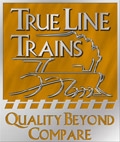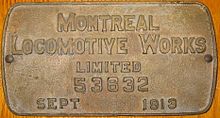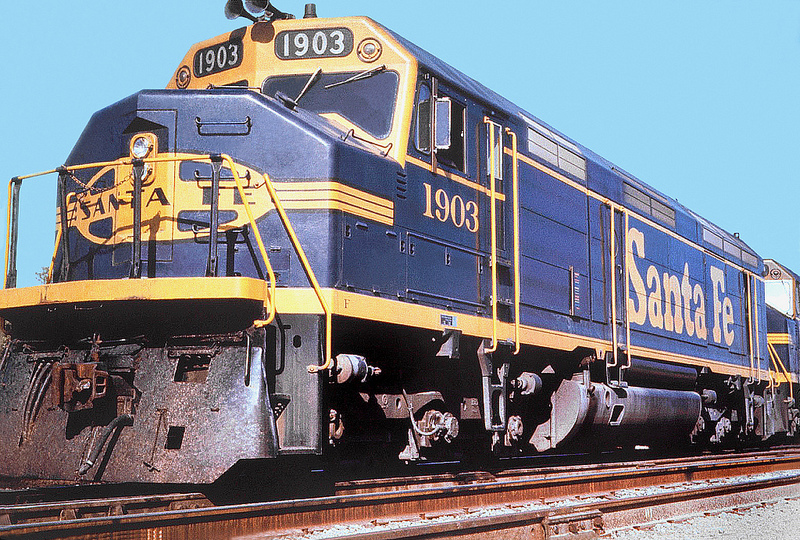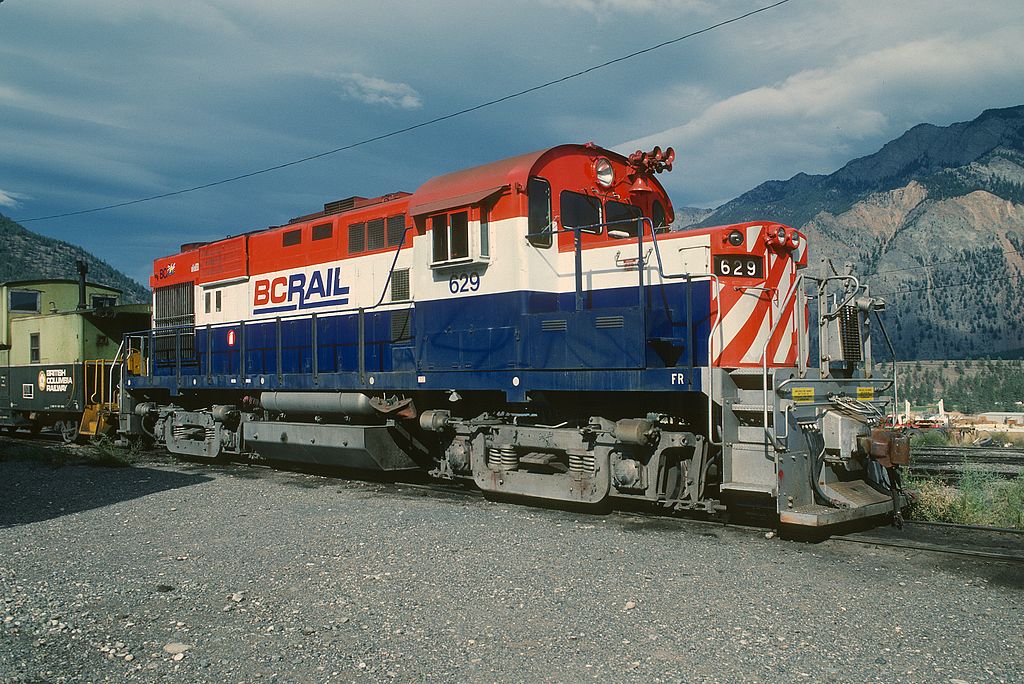Model Information: These locomotives are basically the Chinese-made Atlas RS-11 model (just with a couple of minor variations in shell detailing). The mechanism sports all the features one normally associates with "modern" Atlas diesels - IE, split-frame / all-metal chassis, 5-pole / skew-wound "scale speed" motor, dual flywheels, low-friction drive, bi-directional "white" LED lighting, all-wheel drive and pickup (no traction tires), blackened / low-profile wheels, shell-mounted Accumate couplers, all-plastic gearing, etc. The chassis is fully DCC-Ready.
DCC Information: Accepts the same drop-in decoders as Atlas Alco RS-11:
- Digitrax DN163A0: 1 Amp N Scale Mobile Decoder for Atlas N-Scale GP40-2, U25B, SD35, Trainmaster, B23-7 and others
- TCS AMD4 (Installation for Atlas RS-11)
- NCE N12A0: Plug and play decoder for N-Scale Atlas GP40-2, U25B, U23B, B23-7, 30-7, 36-7, GP38, SD25, TRAINMASTER, etc.
- MRC 1812: N-Scale Sound Decoder for most Atlas short/medium 4-axle locos (selection of 4 prime movers - not prototypical for this model however)
- Digitrax DN163A0: 1 Amp N Scale Mobile Decoder for Atlas N-Scale GP40-2, U25B, SD35, Trainmaster, B23-7 and others
- TCS AMD4 (Installation for Atlas RS-11)
- NCE N12A0: Plug and play decoder for N-Scale Atlas GP40-2, U25B, U23B, B23-7, 30-7, 36-7, GP38, SD25, TRAINMASTER, etc.
- MRC 1812: N-Scale Sound Decoder for most Atlas short/medium 4-axle locos (selection of 4 prime movers - not prototypical for this model however)
Prototype History: The MLW RS-18 was an 1,800 hp (1,340 kW) diesel-electric locomotive built by Montreal Locomotive Works between December 1956 and August 1968. It replaced the RS-10 in MLW's catalogue, and production totalled 351 locomotives, to eight customers. It was the Canadian version of the ALCO RS-11, although MLW did manufacture the RS-11 for Ferrocarriles Nacionales de México.
Canadian National Railway, by far the largest buyer of the RS-18, continued to specify the long hood as the front. By contrast, while all of Canadian Pacific Railway's RS-10s were long-hood-forward, all of their RS-18s were short-hood forward. All of CN and CP's locomotives were delivered with full-height short hoods, as were the first four Pacific Great Eastern Railway, and first Roberval and Saguenay Railway unit. The remaining production was for locomotives with a low short-hood, giving the train crew much better forward vision.
From Wikipedia
Canadian National Railway, by far the largest buyer of the RS-18, continued to specify the long hood as the front. By contrast, while all of Canadian Pacific Railway's RS-10s were long-hood-forward, all of their RS-18s were short-hood forward. All of CN and CP's locomotives were delivered with full-height short hoods, as were the first four Pacific Great Eastern Railway, and first Roberval and Saguenay Railway unit. The remaining production was for locomotives with a low short-hood, giving the train crew much better forward vision.
From Wikipedia
Road Name History: The Canadian Pacific Railway (CPR), formerly also known as CP Rail (reporting mark CP) between 1968 and 1996, is a historic Canadian Class I railroad incorporated in 1881. The railroad is owned by Canadian Pacific Railway Limited (TSX: CP, NYSE: CP), which began operations as legal owner in a corporate restructuring in 2001.
Headquartered in Calgary, Alberta, it owns approximately 23,000 kilometres (14,000 mi) of track all across Canada and into the United States, stretching from Montreal to Vancouver, and as far north as Edmonton. Its rail network also serves major cities in the United States, such as Minneapolis, Milwaukee, Detroit, Chicago, and New York City.
The railway was originally built between Eastern Canada and British Columbia between 1881 and 1885 (connecting with Ottawa Valley and Georgian Bay area lines built earlier), fulfilling a promise extended to British Columbia when it entered Confederation in 1871. It was Canada's first transcontinental railway, but currently does not reach the Atlantic coast. Primarily a freight railway, the CPR was for decades the only practical means of long-distance passenger transport in most regions of Canada, and was instrumental in the settlement and development of Western Canada. The CP became one of the largest and most powerful companies in Canada, a position it held as late as 1975. Its primary passenger services were eliminated in 1986, after being assumed by Via Rail Canada in 1978. A beaver was chosen as the railway's logo because it is the national symbol of Canada and was seen as representing the hardworking character of the company.
The company acquired two American lines in 2009: the Dakota, Minnesota and Eastern Railroad and the Iowa, Chicago and Eastern Railroad. The trackage of the ICE was at one time part of CP subsidiary Soo Line and predecessor line The Milwaukee Road. The combined DME/ICE system spanned North Dakota, South Dakota, Minnesota, Wisconsin, Nebraska and Iowa, as well as two short stretches into two other states, which included a line to Kansas City, Missouri, and a line to Chicago, Illinois, and regulatory approval to build a line into the Powder River Basin of Wyoming. It is publicly traded on both the Toronto Stock Exchange and the New York Stock Exchange under the ticker CP. Its U.S. headquarters are in Minneapolis.
After close of markets on November 17, 2015, CP announced an offer to purchase all outstanding shares of Norfolk Southern Railway, at a price in excess of the US$26 billion capitalization of the United States-based railway. If completed, this merger of the second and fourth oldest Class I railroads in North America would have formed the largest single railway company on that continent, reaching from the Pacific coast to the Atlantic coast to the Gulf Coast. The merger effort was abandoned by Canadian Pacific on April 11, 2016, after three offers were rejected by the Norfolk Southern board.
Read more on Wikipedia and on Canadian Pacific official website.
Headquartered in Calgary, Alberta, it owns approximately 23,000 kilometres (14,000 mi) of track all across Canada and into the United States, stretching from Montreal to Vancouver, and as far north as Edmonton. Its rail network also serves major cities in the United States, such as Minneapolis, Milwaukee, Detroit, Chicago, and New York City.
The railway was originally built between Eastern Canada and British Columbia between 1881 and 1885 (connecting with Ottawa Valley and Georgian Bay area lines built earlier), fulfilling a promise extended to British Columbia when it entered Confederation in 1871. It was Canada's first transcontinental railway, but currently does not reach the Atlantic coast. Primarily a freight railway, the CPR was for decades the only practical means of long-distance passenger transport in most regions of Canada, and was instrumental in the settlement and development of Western Canada. The CP became one of the largest and most powerful companies in Canada, a position it held as late as 1975. Its primary passenger services were eliminated in 1986, after being assumed by Via Rail Canada in 1978. A beaver was chosen as the railway's logo because it is the national symbol of Canada and was seen as representing the hardworking character of the company.
The company acquired two American lines in 2009: the Dakota, Minnesota and Eastern Railroad and the Iowa, Chicago and Eastern Railroad. The trackage of the ICE was at one time part of CP subsidiary Soo Line and predecessor line The Milwaukee Road. The combined DME/ICE system spanned North Dakota, South Dakota, Minnesota, Wisconsin, Nebraska and Iowa, as well as two short stretches into two other states, which included a line to Kansas City, Missouri, and a line to Chicago, Illinois, and regulatory approval to build a line into the Powder River Basin of Wyoming. It is publicly traded on both the Toronto Stock Exchange and the New York Stock Exchange under the ticker CP. Its U.S. headquarters are in Minneapolis.
After close of markets on November 17, 2015, CP announced an offer to purchase all outstanding shares of Norfolk Southern Railway, at a price in excess of the US$26 billion capitalization of the United States-based railway. If completed, this merger of the second and fourth oldest Class I railroads in North America would have formed the largest single railway company on that continent, reaching from the Pacific coast to the Atlantic coast to the Gulf Coast. The merger effort was abandoned by Canadian Pacific on April 11, 2016, after three offers were rejected by the Norfolk Southern board.
Read more on Wikipedia and on Canadian Pacific official website.
Brand/Importer Information: The Canadian distributor for Life-Like products, Hobbycraft Canada, saw a missing segment in market for Canadian model prototypes, and started producing a few Canadian models that were later, with a few modifications, offered in the US market with US roadnames. At a later point Hobbycraft Canada was renamed Life-Like Canada.
When Life-Like was acquired by Walthers, Life-Like Canada was spun off and renamed True Line Trains. They are known as manufacturers of prototypically accurate HO- and N-scale locomotives and freight cars.
When Life-Like was acquired by Walthers, Life-Like Canada was spun off and renamed True Line Trains. They are known as manufacturers of prototypically accurate HO- and N-scale locomotives and freight cars.
Item created by: Alain LM on 2016-07-27 06:14:39. Last edited by gdm on 2018-05-21 09:57:00
If you see errors or missing data in this entry, please feel free to log in and edit it. Anyone with a Gmail account can log in instantly.
If you see errors or missing data in this entry, please feel free to log in and edit it. Anyone with a Gmail account can log in instantly.











